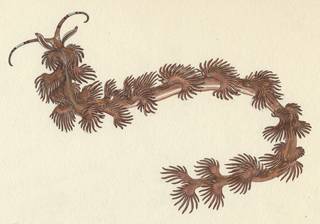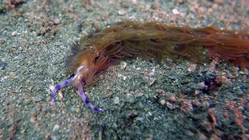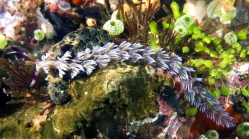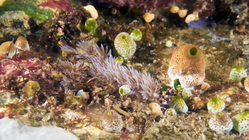MolluscaBase taxon details
Pteraeolidia ianthina (Angas, 1864)
213527 (urn:lsid:marinespecies.org:taxname:213527)
accepted
Species
Flabellina ianthina Angas, 1864 · unaccepted (original combination)
marine
(of Flabellina ianthina Angas, 1864) Angas, G.F. (1864). Description d'espèces nouvelles appartenant à plusieurs genres de mollusques nudibranches des environs de Port-Jackson (Nouvelle-Galles du Sud), accompagnée de dessins faits d'après nature. <em>Journal de Conchyliologie.</em> 12(1): 43-70., available online at https://biodiversitylibrary.org/page/16055237
page(s): 66-67, Plate 6, Figure 6 [details]
page(s): 66-67, Plate 6, Figure 6 [details]
Description Up to 7 cm . One of the most common aeolids found, this species has many clusters of cerata on each side. Body colour can...
Description Up to 7 cm . One of the most common aeolids found, this species has many clusters of cerata on each side. Body colour can be pale to dark purple, although brown and green specimens are not uncommon. The fat rhinophores and very long oral tentacles are banded with violet and white. Brown and green pigments are due to the presence of symbiotic zooaxanthellae which continue to photosynthesise. Nematocysts are also present in the tips of the cerata and these, together with the zooaxanthellae, are presumed to be derived from coelenterate prey. Habitat: diverse, among shallow coral reefs. Distribution: Indo-Pacific. N.B. can inflict a painful sting to humans. [details]
MolluscaBase eds. (2025). MolluscaBase. Pteraeolidia ianthina (Angas, 1864). Accessed at: https://molluscabase.org/aphia.php?p=taxdetails&id=213527 on 2025-09-12
Date
action
by
![]() The webpage text is licensed under a Creative Commons
Attribution 4.0 License
The webpage text is licensed under a Creative Commons
Attribution 4.0 License
original description
(of Flabellina ianthina Angas, 1864) Angas, G.F. (1864). Description d'espèces nouvelles appartenant à plusieurs genres de mollusques nudibranches des environs de Port-Jackson (Nouvelle-Galles du Sud), accompagnée de dessins faits d'après nature. <em>Journal de Conchyliologie.</em> 12(1): 43-70., available online at https://biodiversitylibrary.org/page/16055237
page(s): 66-67, Plate 6, Figure 6 [details]
basis of record Wilson N.G. & Burghardt I. (2015). Here be dragons – phylogeography of <i>Pteraeolidia ianthina</i> (Angas, 1864) reveals multiple species of photosynthetic nudibranchs (Aeolidina: Nudibranchia). <em>Zoological Journal of the Linnean Society.</em> 175(1): 119-133., available online at https://doi.org/10.1111/zoj.12266 [details]
additional source Spencer H.G., Willan R.C., Marshall B.A. & Murray T.J. (2011). Checklist of the Recent Mollusca Recorded from the New Zealand Exclusive Economic Zone. , available online at http://www.molluscs.otago.ac.nz [details]
additional source Gosliner, T. M. (1980 ["1979"]). The systematics of the Aeolidiacea (Nudibranchia: Mollusca) of the Hawaiian Islands, with descriptions of two new species. <em>Pacific Science.</em> 33(1): 37-77., available online at http://scholarspace.manoa.hawaii.edu/handle/10125/1455 [details]
additional source Yorifuji M., Takeshima H., Mabuchi K. & Nishida M. (2012) Hidden diversity in a reef-dwelling sea slug, <i>Pteraeolidia ianthina</i> (Nudibranchia, Aeolidina), in the Northwestern Pacific. <i>Zoological Science</i> 29(6): 359-367. , available online at http://www.bioone.org/doi/full/10.2108/zsj.29.359 [details]
page(s): 66-67, Plate 6, Figure 6 [details]
basis of record Wilson N.G. & Burghardt I. (2015). Here be dragons – phylogeography of <i>Pteraeolidia ianthina</i> (Angas, 1864) reveals multiple species of photosynthetic nudibranchs (Aeolidina: Nudibranchia). <em>Zoological Journal of the Linnean Society.</em> 175(1): 119-133., available online at https://doi.org/10.1111/zoj.12266 [details]
additional source Spencer H.G., Willan R.C., Marshall B.A. & Murray T.J. (2011). Checklist of the Recent Mollusca Recorded from the New Zealand Exclusive Economic Zone. , available online at http://www.molluscs.otago.ac.nz [details]
additional source Gosliner, T. M. (1980 ["1979"]). The systematics of the Aeolidiacea (Nudibranchia: Mollusca) of the Hawaiian Islands, with descriptions of two new species. <em>Pacific Science.</em> 33(1): 37-77., available online at http://scholarspace.manoa.hawaii.edu/handle/10125/1455 [details]
additional source Yorifuji M., Takeshima H., Mabuchi K. & Nishida M. (2012) Hidden diversity in a reef-dwelling sea slug, <i>Pteraeolidia ianthina</i> (Nudibranchia, Aeolidina), in the Northwestern Pacific. <i>Zoological Science</i> 29(6): 359-367. , available online at http://www.bioone.org/doi/full/10.2108/zsj.29.359 [details]
 Present
Present  Inaccurate
Inaccurate  Introduced: alien
Introduced: alien  Containing type locality
Containing type locality
Unreviewed
Description Up to 7 cm . One of the most common aeolids found, this species has many clusters of cerata on each side. Body colour can be pale to dark purple, although brown and green specimens are not uncommon. The fat rhinophores and very long oral tentacles are banded with violet and white. Brown and green pigments are due to the presence of symbiotic zooaxanthellae which continue to photosynthesise. Nematocysts are also present in the tips of the cerata and these, together with the zooaxanthellae, are presumed to be derived from coelenterate prey. Habitat: diverse, among shallow coral reefs. Distribution: Indo-Pacific. N.B. can inflict a painful sting to humans. [details]
To Barcode of Life (44 barcodes)
To Biodiversity Heritage Library (6 publications)
To Biological Information System for Marine Life (BISMaL)
To European Nucleotide Archive, ENA (Pteraeolidia ianthina)
To GenBank (179 nucleotides; 47 proteins) (from synonym Flabellina ianthina Angas, 1864)
To GenBank (179 nucleotides; 47 proteins)
To NMNH Extant Collection (Pteraeolidia ianthina)
To Sea Slug Forum (via archive.org)
To USNM Invertebrate Zoology Mollusca Collection
To Biodiversity Heritage Library (6 publications)
To Biological Information System for Marine Life (BISMaL)
To European Nucleotide Archive, ENA (Pteraeolidia ianthina)
To GenBank (179 nucleotides; 47 proteins) (from synonym Flabellina ianthina Angas, 1864)
To GenBank (179 nucleotides; 47 proteins)
To NMNH Extant Collection (Pteraeolidia ianthina)
To Sea Slug Forum (via archive.org)
To USNM Invertebrate Zoology Mollusca Collection





